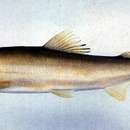Diagnostic Description
provided by FAO species catalogs
Body elongate. Scales small and cycloid; lateral line complete with 145-169 scales. Mouth large; teeth on both jaws small and conical in juveniles; movable, broad, lamelliform (placoids) and 11 to 14 in number on each side in adults. First arch branchial with 46-49 gillrakers. Dorsal fin high, with 10-11 rays; adipose fin present. Anal fin with 14-15 rays. Pectoral with 14. Pelvic fin base below middle of dorsal fin. Vertebrae 59-63.
- Araga, C. - 1984 Plecoglossidae. In: H. Masuda; K. Amaoka; C. Araga; T. Uyeno; T. Yoshino (eds.). The Fishes of the Japanese Archipelago. Tokai. Univ. Press. 33-34.
- Azuma, M. - 1977Specific problems on the "Ayu" fish of Lake Biwa. The Freshwater Fishes, (3): 78-85.
Distribution
provided by FAO species catalogs
Western Pacific Ocean; from western Hokkaido southward in Japan, the Korean Pen., Taiwan, and China.
Size
provided by FAO species catalogs
To about 30 cm; usually 20 cm.
Brief Summary
provided by FAO species catalogs
Typical amphidromous. Adults spawn in the spring, in the lower reaches of rivers. After spawning, some adults die while others return to the sea. Larvae enter the sea immediately after hatching and remain there during winter, feeding on plankton.In springtime, the young (5-7 cm) move upstream to the middle reaches of rivers to feed on algae. Those that are ready to spawn (about 20 cm of total length) move downstream to the lower reaches as well. Some fish spawn two or three years in succession, others only once.
Benefits
provided by FAO species catalogs
Most important species in Japanese freshwater fisheries, highly esteemed as food and game fish. Propagated commercially everywhere in western Japan. The total catch reported for this species to FAO for 1999 was 11 380 t. The countries with the largest catches were Japan (11 380 t). Marketed fresh and consumed fresh, fried and broiled.

